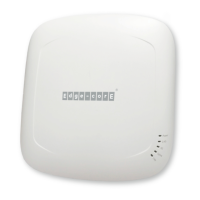User Manual
Enterprise Access Point
48
To delete a specific rule,
Del in the Setting column of firewall list will lead to the following page for removal confirmation. After
the SAVE button is clicked and system is rebooted, the rule will be removed.
To edit a specific rule,
Ed in the Setting column of the firewall list will lead to the following page for detail configuration. From
this page, the rule can be edited from scratch or from an existing rule for revision. The following fields
will be displayed:
Rule ID: The numbering of this specific rule will decide its priority among available firewall rules in the
table.
Rule name: The rule name can be specified here.
EtherType: The drop-down list will provide the available types of traffic subjected to this rule.
Interface: It indicates inbound/outbound direction with desired interfaces.
Service (when EtherType is IPv4): Select the available upper layer protocols/services from the drop-
down list.
DSAP/SSAP (when EtherType is IEEE 802.3): The value can be further specified for the fields in 802.2 LLC
frame header.
Type (when EtherType is IEEE802.3): The field can be used to indicate the type of encapsulated traffic.
VLAN ID (when EtherType is 802.1 Q): The VLAN ID is provided to associate with certain VLAN-tagging
traffic.
Priority (when EtherType is 802.1 Q): It denotes the priority level with associated VLAN traffic.
Encapsulated Type (when EtherType is 802.1 Q): It can be used to indicate the type of encapsulated
traffic.
Opcode (when EtherType is ARP/RARP): This list can be used to specify the ARP Opcode in ARP header.
Source: MAC Address/Mask indicates the source MAC; IP Address/Mask indicates the source IP address
(when EtherType is IPv4); ARP IP/MAC & MASK indicate the ARP payload fields.
Destination: MAC Address/Mask indicates the destination MAC; IP Address/Mask indicates the
destination IP address (when EtherType is IPv4); ARP IP/MAC & MASK indicate the ARP payload fields.

